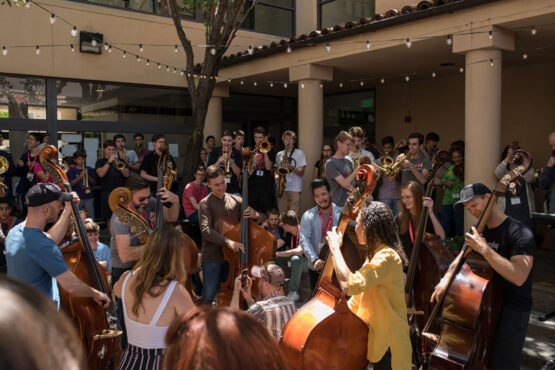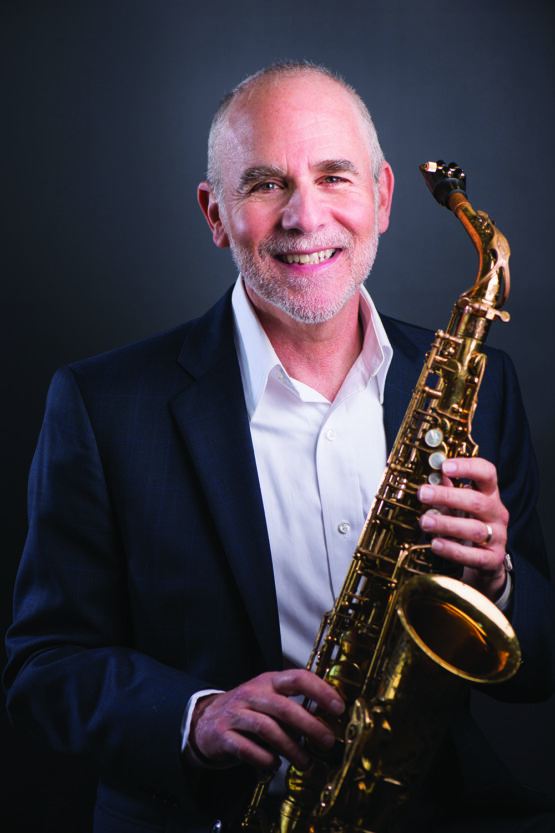Stanford Jazz Workshop celebrates its golden anniversary with the annual summer jazz festival
Artistic director Jim Nadel founded the instructional jazz workshop the summer after graduating from Stanford out of a desire to stay close to the music and build a community of learning.
After two years of digital-only programming, the Stanford Jazz Festival returns this summer with dozens of in-person concerts and free community events featuring local and international artists at indoor and outdoor venues on campus, including Bing Concert Hall, Campbell Recital Hall, Dinkelspiel Auditorium, and Frost Amphitheater. Presented by the globally recognized Stanford Jazz Workshop (SJW), now in its 50th year, this year’s festival will honor founder and artistic director Jim Nadel for his five-decade commitment to jazz education at Stanford.
Legacy of local jazz
Stanford Jazz Workshop is unique among Bay Area music organizations both for its consistent production of performances and education programs, and for its enduring leadership – Nadel has served as artistic director of SJW since its founding in 1972. More than 60 National Endowment for the Arts Jazz Masters have performed and taught at the workshop, and many of jazz’s most revered artists have attended programs as students or faculty members. Today’s festival includes more bands led by women than in earlier years of the festival, and the SJW faculty continues to evolve and reflect the growing inclusivity Nadel wants to see in the future of music.
“The Stanford Jazz Workshop and its always stunning jazz festival have been a pillar of the jazz community at Stanford since its founding 50 years ago,” said long-standing Nadel colleague, music Professor Stephen M. Sano, the Harold C. Schmidt Director of Choral Studies and faculty director of Asian American Studies in the School of the Humanities and Sciences. “The combination of top-flight jazz pedagogy and world-class performers that grace the stage each summer offers the Stanford community an immersive and unparalleled experience. We’re certainly the richer for what SJW and the festival bring to campus.”
The six-week festival runs from June 17 to July 30. Jazz Inside Out with Jim Nadel and Friends kicks off the festival tonight, June 17. The official opening night, June 18, features Eliane Elias. Dianne Reeves and the SJW 50th Anniversary Band close the festival on July 30.
Other artists at this year’s festival include Kenny Barron, Anat Cohen, Taylor Eigsti, Lisa Fischer, Bobby McFerrin, Patrice Rushen, and many more. The complete festival schedule and ticket information can be found here.
Global influences, unique combos
When Nadel graduated from Stanford with a degree in music in 1972, he was deeply steeped in jazz. He spent the summer listening, practicing, and playing his saxophone with friends while thinking about his next steps. It struck the aspiring musician that the many different approaches to playing jazz must also mean there were many different ways of learning it – and teaching it. Nadel’s idea to introduce young musicians to the diverse global expressions of the form through a myriad of jazz performers and performances in a workshop setting blossomed that summer into the Stanford Jazz Workshop, an immersive learning opportunity for student musicians on the Stanford campus.

Participants in the Stanford Jazz Workshop perform outside Tresidder Memorial Union. (Image credit: Courtesy Stanford Jazz Workshop)
In the second decade of the workshop, a residential option for students was added, and the possibilities for public performance increased. “With so many great musicians coming to campus to teach at the workshop, it made sense for them to play for students in the evenings,” said Nadel. “By the mid-1990s, we began to call the ongoing summer faculty concerts the Stanford Jazz Festival. It grew naturally out of the educational experience when we opened the evening concerts to the community.”
The workshop’s Mentor Fellow program, which pairs emerging jazz artists interested in gaining teaching experience with faculty for two years of on-the-job training using SJW’s community-oriented approach, also developed in the 1990s.
From the beginning, the diversity of the SJW faculty’s approaches to jazz brought players together who might not otherwise have crossed paths, allowing students and the public to hear unique combinations of musicians. “By the turn of the century, the density of the festival performances was extraordinary and something that wasn’t really found outside of New York City,” said Nadel. “No purely commercial presenter would flood the market with so much great music in a short timeframe!”
The sound of learning
In pre-pandemic years, SJW staged free middle and high school performances around the Bay Area and produced free jam sessions at the on-campus Coho cafe, drawing hundreds of students, community members, and amateur musicians. Summer jazz immersion programs, which run this year from July 5 to July 11, include the intensive on-campus Jazz Camps, the Giant Steps Day Camp for middle school students, the Jazz Institute for self-guided students, and digital-only offerings.
“Over the years, SJW has kept education as its core mission. That continues to define the character and content of our festival experience, bringing students and teachers together and giving the community the chance to hear musical combinations that grow out of that interaction. As artists and students return year after year, the quality of the performances reflects the deepening of the musical relationships that are forged at SJW,” said Nadel.
Nadel has been a lecturer for 35 years in Stanford’s Department of Music, whose ties with SJW are deep and longstanding. More than 100 SJW alumni have subsequently enrolled at Stanford. Nadel designed the initial jazz studies curriculum for the university’s academic jazz program, and the workshop itself has offered teaching artists the visibility and vetting that would lead to opportunities for involvement with the university’s academic program.
Joshua Redman attended a summer jazz workshop as a Berkeley High School student in 1985. The tenor saxophonist later returned as an SJW faculty member before being appointed a Mohr Visiting Artist hosted by the Stanford Department of Music in 2019. Today, he teaches and performs on campus as a Stanford Visiting Educator.
“The best practices and teaching materials that SJW has evolved over the decades have become resources for the department’s academic program, and often the best of the SJW teaching/artists have been invited to visit campus to work with and perform with Stanford students,” said Nadel. “I’m particularly happy about this synergy.”

